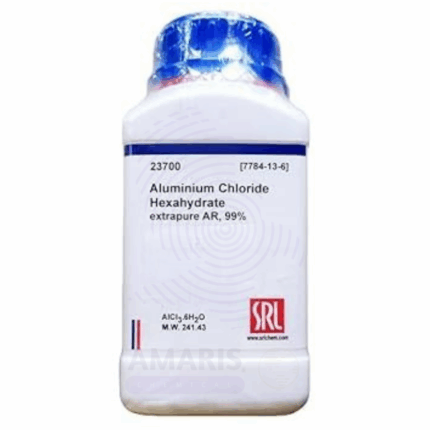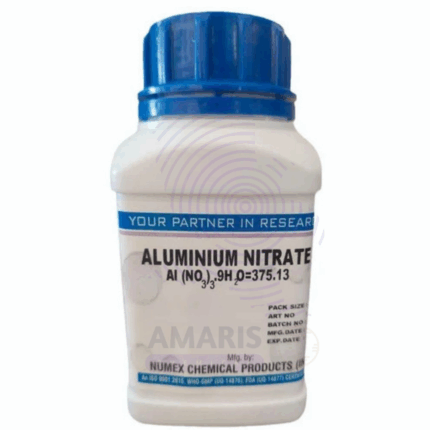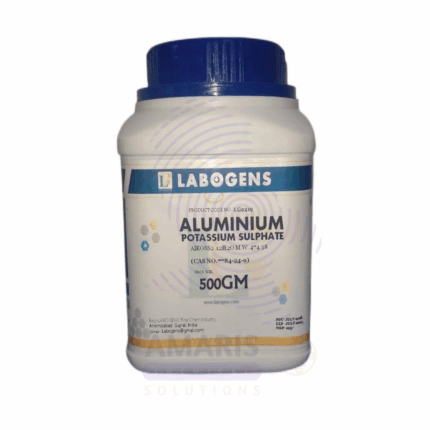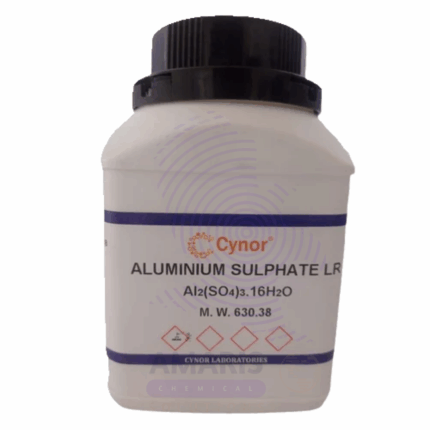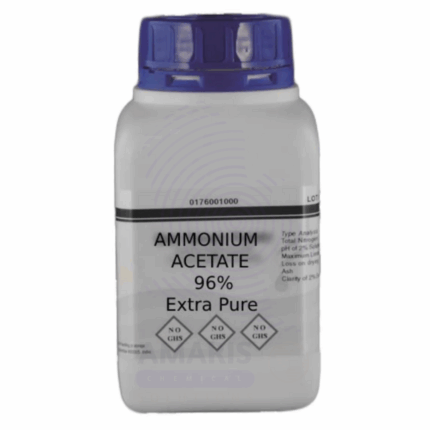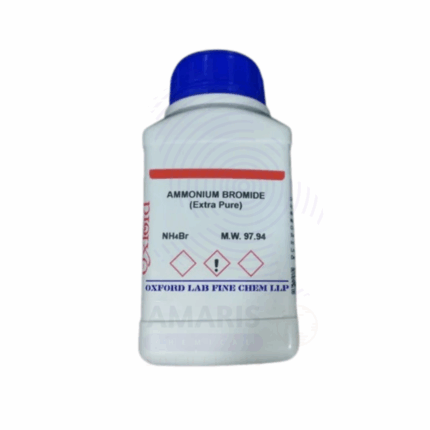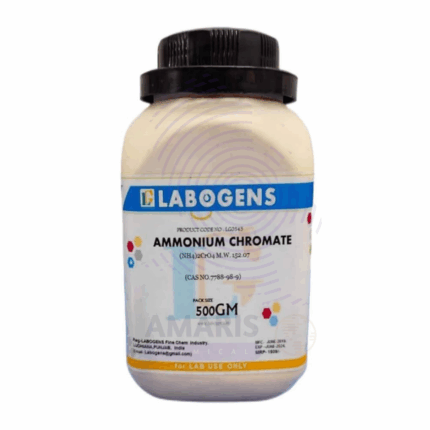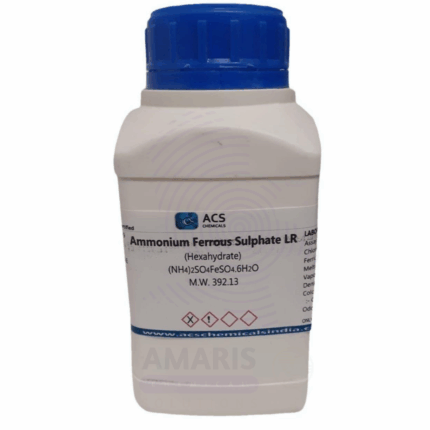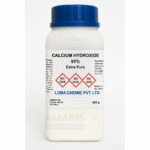
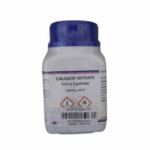
Calcium Metal Extra Pure
$ 19.00 Original price was: $ 19.00.$ 18.34Current price is: $ 18.34.
Calcium Metal Extra Pure is a high-purity, silvery-white alkaline earth metal used extensively in laboratory settings for its strong reducing properties and high reactivity. It plays a vital role in metallothermic reductions, particularly for extracting reactive metals like uranium, thorium, and zirconium from their oxides or halides. In controlled experiments, it is also used to generate hydrogen gas when reacted with water and to study exothermic redox reactions. The extra pure grade ensures low impurity levels, which is critical for precise synthesis and analytical work. Due to its high reactivity with air and moisture, it must be handled under inert conditions and stored in airtight containers or under oil to prevent oxidation.
Calcium Metal Extra Pure
Primary Uses
- Strong Reducing Agent in Organic & Inorganic Synthesis
- Calcium metal is widely used in reduction reactions, such as the reduction of metal oxides or halides to their elemental forms.
- Dehydration of Solvents and Gases
- Used to dry alcohols, ethers, and hydrocarbons by reacting with residual moisture due to its strong reactivity with water.
- Study of Alkaline Earth Metal Properties
- Used in educational demonstrations to show typical reactions of Group 2 metals, especially reactions with water, acids, and oxygen.
- Production of Calcium Compounds in Situ
- Reacted with acids to generate calcium salts or with water to produce calcium hydroxide and hydrogen gas.
Secondary Uses
- Alloy Preparation in Metallurgical Labs
- Occasionally used in lab-scale metallurgical processes or in alloy formulation for experimental purposes.
- Getter Material in High-Vacuum Systems
- Acts as a getter to trap oxygen, nitrogen, and other reactive gases in vacuum tubes or controlled-atmosphere experiments.
- Spectroscopic and Combustion Studies
- Used in flame tests to demonstrate characteristic orange-red coloration, or in combustion reactions to study metal reactivity.
- Electrochemical Research
- Studied for its potential role in metal-ion batteries or ionic conduction in advanced materials research.
| PACK SIZE |
500 grams Plastic Tin |
|---|
1. Basic Identification Attributes
- Chemical Name: Calcium
- Chemical Formula: Ca
- CAS Number: 7440-70-2
- HS Code: 2805.12.00
- Grade: Extra Pure (Laboratory Grade)
- Synonyms: Metallic Calcium, Calcium Granules
2. Physical & Chemical Properties
- Appearance: Silvery-white, soft metal (often in turnings or granules)
- Odor: Odorless
- Molar Mass: 40.08 g/mol
- Melting Point: 842 °C
- Boiling Point: 1,484 °C
- Density: 1.55 g/cm³
- Solubility: Reacts with water; not soluble in most solvents
- Reactivity: Highly reactive, especially with water and acids
- Flammability: Combustible in air; may ignite spontaneously when finely divided
3. Safety & Hazard Attributes
- GHS Classification:
- Water-reactive Substance (Category 1)
- Skin Corrosive (Category 1)
- Hazard Statements:
- H260: In contact with water releases flammable gases which may ignite spontaneously
- H314: Causes severe skin burns and eye damage
- Precautionary Statements:
- Keep away from moisture
- Handle only under inert atmosphere (e.g., argon) if purity must be preserved
- Wear protective gloves, eye protection, and lab coat
4. Storage & Handling Attributes
- Storage Conditions:
- Store in tightly sealed containers under mineral oil or inert gas
- Keep away from moisture, acids, and oxidizers
- Packaging: Sealed glass or metal containers under inert liquid or vacuum
- Handling Precautions:
- Use forceps or gloves
- Do not handle with wet hands
- Avoid contact with water and humid air
5. Regulatory & Compliance Attributes
- Transport Classification:
- UN No.: 1401
- Class: 4.3 (Substances which, in contact with water, emit flammable gases)
- Packaging Group: I
- Disposal Considerations:
- Neutralize slowly with isopropanol under controlled conditions
- Dispose according to local hazardous waste regulations
6. Environmental & Health Impact
- Toxicity:
- Can cause thermal and chemical burns on contact
- Inhalation of dust or fumes can irritate respiratory tract
- Ecotoxicity:
- Reacts with water, releasing alkaline calcium hydroxide
- May alter pH and disrupt aquatic life
- Biodegradability: Not applicable (elemental metal)
SAFETY PRECAUTIONS
- Personal Protective Equipment (PPE):
- Wear chemical splash goggles, flame-resistant lab coat, and gloves (non-reactive, like nitrile).
- Use a face shield and fume hood when handling large amounts or open flames.
- Handling:
- Handle under inert atmosphere (argon or nitrogen) if possible, or in mineral oil to prevent oxidation.
- Avoid contact with water, moisture, or air, as calcium reacts vigorously, producing heat and hydrogen gas (flammable).
- Use non-sparking tools and grounding when transferring.
- Storage:
- Store in tightly sealed containers, under oil, dry argon, or in a desiccator.
- Keep away from water, acids, and oxidizers.
FIRST AID MEASURES
- Inhalation (if dust is generated):
- Move to fresh air immediately.
- Seek medical attention if symptoms like coughing or shortness of breath occur.
- Skin Contact:
- Brush off any particles.
- Wash the area thoroughly with soap and water.
- Do not apply water directly to unreacted metal on skin — may cause burns due to reaction.
- Eye Contact:
- Rinse immediately with copious water for 15+ minutes.
- Keep eyelids open and seek immediate medical attention.
- Ingestion:
- Do not induce vomiting.
- Rinse mouth with water.
- Seek immediate emergency medical help — reacts with water in the digestive tract.
FIRE FIGHTING MEASURES
- Flammability:
- Highly flammable in powder or granule form.
- Reacts with water to release flammable hydrogen gas.
- Extinguishing Media:
- Use Class D dry powder extinguishers (like graphite, soda ash, or dry sand).
- Do NOT use water, CO₂, or foam — these may cause explosive reactions.
- Hazardous Combustion Products:
- Calcium oxide fumes, hydrogen gas, and intense heat.
- Firefighter Protection:
- Use self-contained breathing apparatus (SCBA) and full-body protective gear.
- Approach from upwind and avoid contact with water-based extinguishers.


 Preservatives(food)
Preservatives(food) Flavor Enhancers
Flavor Enhancers Acidulants
Acidulants Sweeteners
Sweeteners Antioxidants
Antioxidants Colorants(food)
Colorants(food) Nutraceutical Ingredients (food)
Nutraceutical Ingredients (food) Nutrient Supplements
Nutrient Supplements Emulsifiers
Emulsifiers
 Collectors
Collectors Dust Suppressants
Dust Suppressants Explosives and Blasting Agents
Explosives and Blasting Agents Flocculants and Coagulants
Flocculants and Coagulants Frothers
Frothers Leaching Agents
Leaching Agents pH Modifiers
pH Modifiers Precious Metal Extraction Agents
Precious Metal Extraction Agents
 Antioxidants(plastic)
Antioxidants(plastic) Colorants (Pigments, Dyes)
Colorants (Pigments, Dyes) Fillers and Reinforcements
Fillers and Reinforcements Flame Retardants
Flame Retardants Monomers
Monomers Plasticizers
Plasticizers Polymerization Initiators
Polymerization Initiators Stabilizers (UV, Heat)
Stabilizers (UV, Heat)
 Antifoaming Agents
Antifoaming Agents Chelating Agents
Chelating Agents Coagulants and Flocculants
Coagulants and Flocculants Corrosion Inhibitors
Corrosion Inhibitors Disinfectants and Biocides
Disinfectants and Biocides Oxidizing Agents
Oxidizing Agents pH Adjusters
pH Adjusters Scale Inhibitors( water)
Scale Inhibitors( water)
 Antioxidants(cosmetic)
Antioxidants(cosmetic) Emollients
Emollients Fragrances and Essential Oils
Fragrances and Essential Oils Humectants
Humectants Preservatives
Preservatives Surfactants(cosmetic)
Surfactants(cosmetic) Thickeners
Thickeners UV Filters
UV Filters
 Fertilizers
Fertilizers Soil Conditioners
Soil Conditioners Plant Growth Regulators
Plant Growth Regulators Animal Feed Additives
Animal Feed Additives Biostimulants
Biostimulants Pesticides (Herbicides, Insecticides, Fungicides)
Pesticides (Herbicides, Insecticides, Fungicides)
 Active Pharmaceutical Ingredients (APIs)
Active Pharmaceutical Ingredients (APIs) Excipients
Excipients Solvents(pharmaceutical)
Solvents(pharmaceutical) Antibiotics
Antibiotics Antiseptics and Disinfectants
Antiseptics and Disinfectants Vaccine Adjuvants
Vaccine Adjuvants Nutraceutical Ingredients (pharmaceutical)
Nutraceutical Ingredients (pharmaceutical) Analgesics & Antipyretics
Analgesics & Antipyretics
 Analytical Reagents
Analytical Reagents Solvents(lab)
Solvents(lab) Chromatography Chemicals
Chromatography Chemicals Spectroscopy Reagents
Spectroscopy Reagents microbiology-and-cell-culture-reagents
microbiology-and-cell-culture-reagents Molecular Biology Reagents
Molecular Biology Reagents Biochemical Reagents
Biochemical Reagents Inorganic and Organic Standards
Inorganic and Organic Standards Laboratory Safety Chemicals
Laboratory Safety Chemicals Specialty Laboratory Chemicals(Special Laboratory Equipment)
Specialty Laboratory Chemicals(Special Laboratory Equipment)
 Demulsifiers
Demulsifiers Hydraulic Fracturing Fluids
Hydraulic Fracturing Fluids Scale Inhibitors(oil)
Scale Inhibitors(oil) Surfactants(oil)
Surfactants(oil) Drilling Fluids
Drilling Fluids
 Dyes and Pigments
Dyes and Pigments Bleaching Agents
Bleaching Agents Softening Agents
Softening Agents Finishing Agents
Finishing Agents Antistatic Agents
Antistatic Agents
 Admixtures
Admixtures Waterproofing Agents
Waterproofing Agents Sealants and Adhesives
Sealants and Adhesives Curing Compounds
Curing Compounds Concrete Repair Chemicals
Concrete Repair Chemicals Anti-Corrosion Coatings
Anti-Corrosion Coatings
 Surfactants(cleaning)
Surfactants(cleaning) Builders
Builders Enzymes
Enzymes Solvents (Cleaning)
Solvents (Cleaning) Fragrances
Fragrances
 Electronic Chemicals
Electronic Chemicals Catalysts
Catalysts Lubricants
Lubricants Photographic Chemicals
Photographic Chemicals Refrigerants
Refrigerants Automotive chemicals
Automotive chemicals Pyrotechnic Chemicals
Pyrotechnic Chemicals
 Biodegradable Surfactants
Biodegradable Surfactants Bio-based Solvents
Bio-based Solvents Renewable Polymers
Renewable Polymers Carbon Capture Chemicals
Carbon Capture Chemicals Wastewater Treatment Chemicals
Wastewater Treatment Chemicals
 Pigments
Pigments Solvents(paint)
Solvents(paint) Specialty Coatings
Specialty Coatings Binders/Resins
Binders/Resins Additives
Additives Driers
Driers Anti-Corrosion Agents
Anti-Corrosion Agents Functional Coatings
Functional Coatings Application-Specific Coatings
Application-Specific Coatings
 Fresh Herbs
Fresh Herbs Ground Spices
Ground Spices Whole Spices
Whole Spices Spice Blends
Spice Blends Dried Herbs
Dried Herbs
 Leavening Agents
Leavening Agents Dough Conditioners
Dough Conditioners Flour Treatments
Flour Treatments Fat Replacers
Fat Replacers Decoratives
Decoratives Preservatives(baking)
Preservatives(baking)
 Plasticizers & Softeners
Plasticizers & Softeners Reinforcing Agents
Reinforcing Agents Adhesion Promoters
Adhesion Promoters Vulcanizing Agents
Vulcanizing Agents Antidegradants
Antidegradants Blowing Agents
Blowing Agents Fillers & Extenders
Fillers & Extenders Accelerators & Retarders
Accelerators & Retarders

